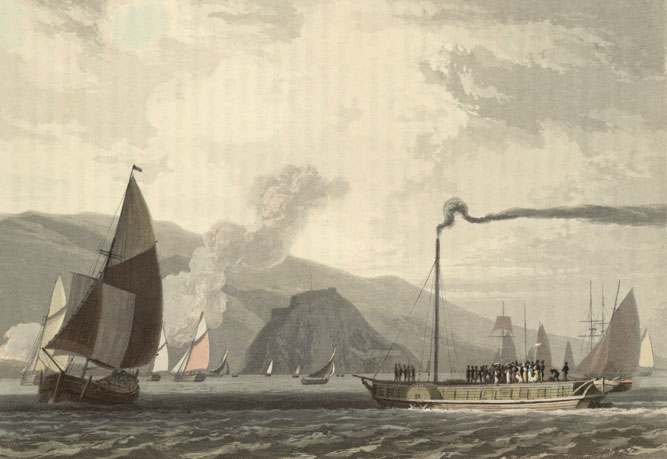DANIELL, William (1769-1837)
Steam Boat on the Clyde

© National Library of Scotland.
William Daniell image supplied by the National Library of Scotland for use in the LEMA Project.
[Plate 17]
Steamboats
"...In proceeding from Greenock up to Dumbarton, which indeed is beyond the limits of a coasting voyage, a conveyance offered itself which forms a very striking peculiarity in the navigation of the Clyde. This was the steam-boat, of which a sufficient number have been established to maintain a constant intercourse between Glasgow and Greenock. They can depart during any period of the tide and in all winds, and perform the voyage generally in three hours 'or three hours and a half. An idea may be formed of these vessels by reference to the VIEW OF STEAM-BOATS ON THE CLYDE, NEAR DUMBARTON. It is observable that the smoke of the engine is carried off by a tall cast-iron chimney, bearing the semblance of a mast, and sometimes serving as a substitute for one when the state of the wind will allow a sail to be hoisted with advantage. The stream of smoke from the orifice generally takes a horizontal direction, in consequence of the movement of the vessel forming a pendant of extraordinary length and very singular appearance. By this signal the people can distinguish the steam-boats at a very great distance. They are fitted up in a style similar to that of the packet-boats on navigable canals. The principal cabin for passengers is furnished with draught and chess boards, back-gammon tables, and other implements of pastime, as well as with a small library of that description of books denominated light reading; on the roof there are chairs and benches for the convenience of those who, in fine weather, choose to enjoy the delightful prospects that present themselves on both shores of the Clyde. The space before the mast, or near the steam engine, answering to what is called the steerage passage, is allotted at half-price to those who can put up with inferior accommodations for the sake of travelling at a very cheap rate. The steam-boat takes in and lands passengers at Dumbarton and Port Glasgow, and the mechanism of her motion is such as to allow her to touch at those places with the least possible delay, and to lie to or resume her course with equal promptitude. Her rate of moving is delightfully uniform and rapid; and it is particularly amusing to observe with what ease she will outstrip a vessel though under full sail.
About the period here alluded to there were six steam-packets plying on the river, two of which carried goods as well as passengers. Larger boats with more powerful engines were then constructing; among others, one of about 100 feet keel and 17 feet beam, with an engine of 24 horses power, and one of equal burthen, having an engine of 30 horses power. The vessels in starting take advantage of the tide as far as circumstances will permit; but as they depart at different hours from the same place, they are obliged sometimes to go part or nearly the whole of their course against the tide. Against a moderate breeze of contrary wind, with the tide favourable, the voyage has been performed in two hours and a quarter. The mail-coach between Glasgow and Greenock was allowed three hours and a half, and though, by extraordinary exertion, some of the coaches were made to run that distance in an hour less time, yet a decided preference was soon given to the steam-boats, on account of the facility and cheapness of the conveyance. One of them has been known to carry two hundred and forty-seven persons at a time; and in fine summer weather from five to six hundred have gone from Glasgow to Port Glasgow and Greenock and returned the same day. The easy passage, and the fine scenery which it commands, have induced many persons to make this a mere excursion of pleasure; and the bathing places below Greenock, furnishing an unexceptionable apology for a trip of this kind, are beginning to be very much frequented. The first steam-boats that succeeded in Scotland were planned by Mr. Bell of Helensburgh, and built by Messrs. John Wood and Co. of Port Glasgow.
One of the most remarkable objects in the course of the voyage is the rock of Dumbarton with its castle, included in the view above referred to. The spreading volume of smoke which appears to proceed from the verge of the shore, arises from a manufactory of bottle and crown glass, situated near the town, which stands on a peninsula formed by the winding of the Leven at its junction with the Clyde. The rock is divided by a fissure about mid-way, and has two summits; on the lower are several batteries mounted with cannon. The higher and narrower summit commands very extensive views: toward the north is seen Loch Lomond and .the rugged mountains in its neighbourhood, the most conspicuous of which is the lofty Ben Lomond. Between the loch and the Clyde extends the rich vale of Leven with its meandering river. The prospect down the Firth includes the towns of Port Glasgow and Greenock, and is terminated on the right by a majestic range of mountains, more picturesque in form and outline than perhaps any other estuary in the island can boast. In clear weather, the view eastward extends beyond the city of Glasgow."
Source: Extract from DANIELL, William. A Voyage Round Great Britain [1813-1823].
Back to Scotland: Gallery





